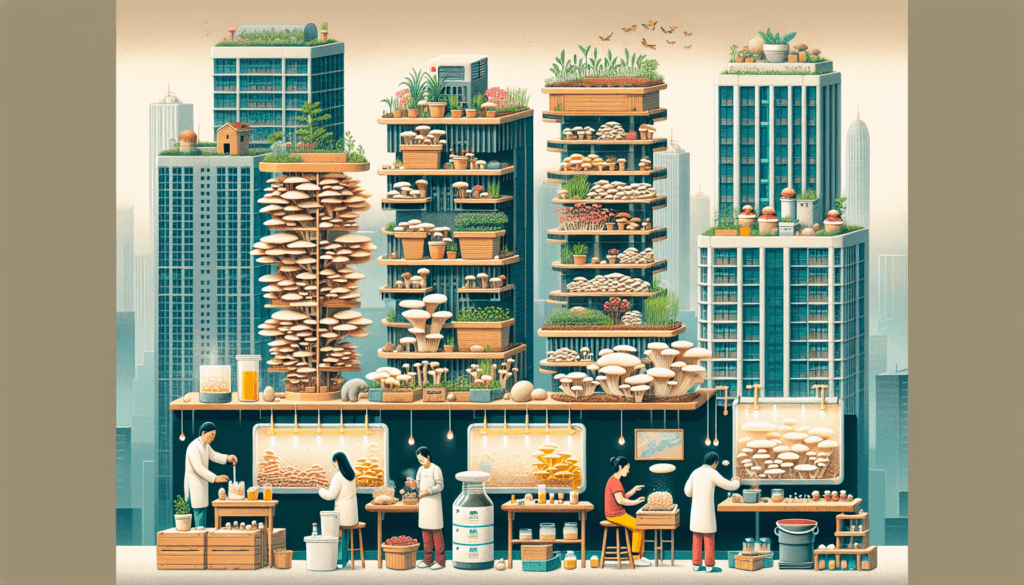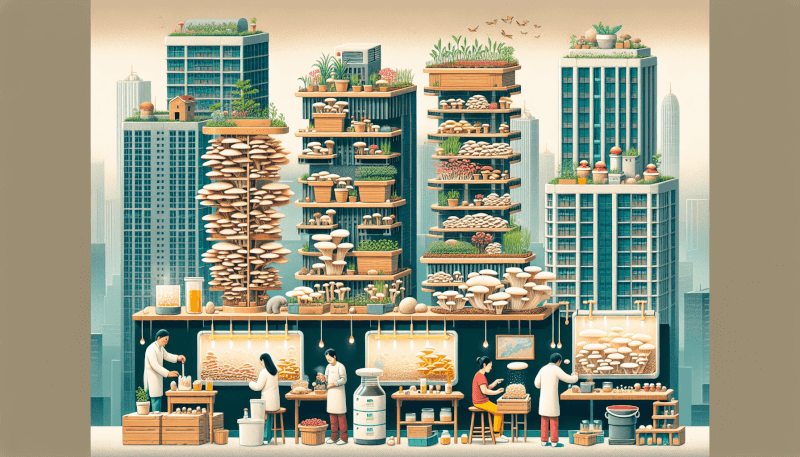If you’ve always been fascinated by the idea of growing your own mushrooms but thought it was impossible because you live in the city, think again! In this article, we’ll explore the best ways to grow mushrooms in an urban setting. From utilizing small spaces to choosing the right mushroom varieties, we’ll provide you with practical tips and techniques that will have you enjoying a bountiful harvest of fresh mushrooms right in the comfort of your own urban environment. So, grab a spore syringe and get ready to embark on a journey of mushroom cultivation like never before!

Choosing the Right Type of Mushroom
When it comes to growing mushrooms, the first step is to choose the right type of mushroom for your needs and growing conditions. There are many different species of mushrooms, each with its own unique requirements and characteristics. Some popular options for urban mushroom farming include oyster mushrooms, shiitake mushrooms, and white button mushrooms.
Identifying suitable mushroom species
Before you begin your mushroom cultivation journey, it’s important to research and identify which mushroom species are suitable for growing in an urban setting. Consider factors such as the temperature and humidity requirements of different mushroom species, as well as their preferred growing medium. This will help you determine which mushrooms are most likely to thrive in your environment.
Considering climate and growing conditions
Urban environments can vary greatly in terms of climate and growing conditions. Take into account factors such as temperature, humidity, and sunlight availability when selecting the right mushroom species for your urban farm. Some mushroom varieties may require specific conditions to grow successfully, so make sure to choose species that are compatible with your climate and growing conditions.
Considering space and container options
In an urban setting, space is often limited, which means you may need to get creative when it comes to finding a suitable growing space for your mushrooms. Consider options such as using indoor containers, vertical farming techniques, or even utilizing outdoor spaces like rooftops or balconies. Choose containers or growing systems that are suitable for the type of mushroom you’re cultivating and ensure they provide adequate airflow and drainage.
Preparation and Set-Up
Before you start growing mushrooms, it’s important to prepare and set up your growing area properly. This involves gathering the necessary materials and equipment, creating a sterile environment, and preparing the substrate for mushroom growth.
Gathering necessary materials and equipment
To get started with mushroom cultivation, you’ll need several key materials and equipment. These may include mushroom spawn or spores, a growing medium such as straw or sawdust, containers or trays, a spray bottle for misting, and a thermometer and hygrometer to monitor temperature and humidity. Additionally, you may need a pressure cooker or autoclave to sterilize your growing medium and containers.
Creating a sterile environment
Creating a sterile environment is crucial to prevent contamination and ensure the healthy growth of your mushrooms. Start by thoroughly cleaning your growing area and equipment with a mild bleach solution or other disinfectant. It’s also important to wear gloves and a face mask when handling your growing medium and mushrooms to reduce the risk of introducing harmful bacteria or spores.
Preparing the substrate for mushroom growth
The substrate, or growing medium, is the material on which your mushrooms will grow. The type of substrate you use will depend on the species of mushroom you are growing. Popular options include straw, sawdust, or a mixture of the two. Before using the substrate, it must be pasteurized or sterilized to eliminate any potential contaminants. This can be done using a pressure cooker, autoclave, or by boiling the substrate.
Growing Mushrooms Indoors
Growing mushrooms indoors is a popular option for urban farmers due to the control it offers over environmental conditions. There are several methods you can use to grow mushrooms indoors, including using mushroom kits, creating a fruiting chamber, and maintaining optimal growing conditions.
Using mushroom kits
Mushroom kits are a convenient and beginner-friendly option for growing mushrooms indoors. These kits typically come with pre-inoculated substrate and provide step-by-step instructions for growing your mushrooms. They are a great option for those who are new to mushroom cultivation or have limited space.
Creating a fruiting chamber
A fruiting chamber is a controlled environment that mimics the natural conditions needed for mushrooms to grow and develop properly. It provides the necessary humidity, temperature, and airflow for the mushrooms to flourish. You can create a simple fruiting chamber using plastic storage containers, a humidifier or mister, and a thermometer and hygrometer to monitor the conditions.
Maintaining optimal growing conditions
To ensure the success of your indoor mushroom farm, it’s important to maintain optimal growing conditions. Different mushroom species have different temperature and humidity requirements, so it’s crucial to research and understand the specific needs of the mushrooms you are cultivating. Regularly monitor and adjust the temperature, humidity, and airflow within your growing area to create an environment that promotes healthy mushroom growth.
Growing Mushrooms Outdoors
If you have access to outdoor spaces such as a garden, rooftop, or balcony, you can also grow mushrooms outdoors. This can provide a larger growing area and naturally occurring environmental factors that can benefit mushroom cultivation. Here are some steps to follow when growing mushrooms outdoors.
Selecting an outdoor growing location
When choosing an outdoor location for your mushroom farm, consider factors such as sunlight exposure, protection from strong winds, and the accessibility of water sources. Mushroom cultivation benefits from shaded areas with indirect sunlight, as direct sunlight can damage or dry out the mushrooms. Additionally, choose an area that is easily accessible for daily maintenance and observation.
Creating mushroom beds or patches
Mushrooms grown outdoors can be planted in designated beds or patches. This involves preparing the soil or growing medium and inoculating it with mushroom spawn or spores. The bed should be well-drained and enriched with organic matter such as compost or aged manure. Ensure the bed or patch is properly mulched to retain moisture and discourage weed growth.
Providing environmental controls
While outdoor mushroom cultivation relies on natural environmental conditions, it’s still important to provide some level of control. Protect your mushroom beds or patches from extreme temperature fluctuations, heavy rainfall, or prolonged dry spells by using shade cloths, mulch, or protective coverings. Regularly monitor and adjust watering to ensure the growing medium remains moist but not waterlogged.

Urban Mushroom Farming Techniques
In an urban setting, space is often limited, which necessitates the use of innovative farming techniques to maximize productivity. Here are three techniques commonly used in urban mushroom farming:
Utilizing vertical farming methods
Vertical farming is a technique that involves stacking growing layers vertically, allowing for more plants or mushrooms to be cultivated in a smaller footprint. This technique can be achieved using shelving units, racks, or specially designed systems that provide adequate light, airflow, and drainage to each layer. Vertical farming is especially useful for urban mushroom farmers looking to make the most of limited space.
Exploring hydroponic mushroom cultivation
Hydroponic mushroom cultivation is a soilless growing technique that involves growing mushrooms in a nutrient-rich water solution. This method allows for precise control over nutrient uptake and provides a clean, disease-free growing environment. Hydroponic systems can be designed for small-scale urban mushroom farming, utilizing containers or trays with appropriate drainage and nutrient delivery systems.
Implementing aeroponic systems
Aeroponics is an advanced farming technique that involves growing plants or mushrooms in an air or mist environment without the use of soil. It can be a suitable option for urban mushroom farmers due to its space-saving capabilities and efficient use of resources. Aeroponic systems typically involve suspending mushroom roots in a mist of nutrient-rich water, allowing for optimal nutrient absorption and growth.
Managing Light and Temperature
Light and temperature are crucial factors in mushroom cultivation, as they directly influence growth and fruiting. Understanding the light requirements of mushrooms, controlling temperature and humidity levels, and using artificial lighting in the absence of natural light are essential for successful mushroom farming.
Understanding the light requirements of mushrooms
Different mushroom species have varying light requirements. While some mushrooms prefer indirect or diffused light, others thrive in complete darkness. Research the specific light requirements of the mushroom species you are growing and place them in an appropriate location accordingly. If growing indoors, consider using artificial lights to provide the necessary light spectrum and duration.
Controlling temperature and humidity levels
Maintaining optimal temperature and humidity levels is crucial for the successful growth of mushrooms. Different species have different temperature and humidity requirements, so it’s important to research and understand the specific needs of your chosen mushrooms. Use thermometers and hygrometers to monitor and adjust the temperature and humidity within your growing area. The ideal temperature and humidity levels will depend on the specific species being cultivated.
Using artificial lighting in the absence of natural light
In an urban setting, access to natural light may be limited. This can be addressed by using artificial lighting to supplement or replace natural light sources. LED lights are a popular choice among indoor mushroom farmers as they are energy-efficient and can be adjusted to provide the specific light spectrum and intensity required by the mushrooms. Position the lights at an appropriate distance above the mushrooms to ensure proper illumination without causing heat stress.

Watering and Fertilization
Proper watering and fertilization are essential for the healthy growth of mushrooms. Understanding the appropriate watering schedule, choosing organic fertilizers, and avoiding overwatering and over-fertilization are key considerations when cultivating mushrooms.
Determining the appropriate watering schedule
Mushrooms require consistent moisture levels to grow, but overwatering can lead to rot and other issues. It’s important to strike a balance when watering your mushrooms. The exact watering schedule will depend on factors such as the species being cultivated, the humidity levels, and the substrate being used. Generally, a misting or spraying method is preferred to avoid damaging delicate mushroom caps.
Choosing organic fertilizers for mushroom cultivation
Organic fertilizers are the preferred choice for mushroom cultivation as they provide necessary nutrients without the risk of harmful chemicals or excessive nutrient levels. Common organic fertilizers used in mushroom farming include compost, aged manure, worm castings, and organic liquid fertilizers. These can be added to the growing medium before inoculation or during the fruiting stage to provide beneficial nutrients.
Avoiding overwatering and over-fertilization
Overwatering and over-fertilization can lead to nutrient imbalance and promote the growth of harmful fungi or bacteria. It’s important to avoid these issues by carefully monitoring the moisture levels in the growing medium and using fertilizers sparingly. Mushrooms are sensitive to changes in their environment, so it’s best to err on the side of caution and provide just enough water and nutrients to support healthy growth.
Pest and Disease Control
Pests and diseases can pose a threat to mushroom crops, affecting their growth and overall yield. Identifying common mushroom pests, implementing preventive measures, and using organic pest control methods are essential for effective pest and disease control.
Identifying common mushroom pests
Common pests that can attack mushroom crops include fungus gnats, mites, and slugs. These pests can cause damage to the mushrooms and even introduce diseases. Regularly inspect your growing area for signs of pests, such as chewed leaves, presence of larvae or eggs, or visible insects. Identifying the specific pests will help you choose the appropriate pest control measures.
Implementing preventive measures
Preventing pest and disease infestations is crucial for maintaining a healthy mushroom farm. Make sure to maintain a clean and hygienic growing environment, removing any plant debris or organic matter that may attract pests. Regularly inspect your mushrooms for signs of disease or infection, and immediately remove any affected mushrooms or substrate to prevent the spread of pathogens.
Using organic pest control methods
When pests do appear, it’s important to tackle the issue using organic pest control methods to avoid introducing harmful chemicals into your growing area. Some effective organic pest control measures for mushrooms include using neem oil or insecticidal soap sprays, introducing natural predators such as beneficial insects, or employing physical barriers to prevent pests from accessing the mushrooms.

Harvesting and Proper Handling
Knowing when and how to harvest mushrooms is crucial to ensure optimal flavor, texture, and shelf life. Recognizing the signs of mushroom readiness, harvesting at the right time, and properly storing and preserving harvested mushrooms are important considerations for growers.
Recognizing the signs of mushroom readiness
Each mushroom species has its own unique signs of readiness for harvesting. Typically, mushrooms are ready to be harvested when the caps are fully expanded and the gills are visible. Additionally, the mushrooms should have a firm texture and should not show signs of spore release or deterioration. Regularly monitor your mushrooms and harvest them as soon as they reach the desired level of maturity.
Harvesting mushrooms at the right time
Timing is crucial when harvesting mushrooms to maximize their quality and flavor. Harvesting too early may result in underdeveloped mushrooms, while harvesting too late can lead to overmature mushrooms with a reduced shelf life. Use a sharp knife or scissors to cut the mushrooms at the base of the stem, taking care not to damage the surrounding substrate or other mushrooms.
Storing and preserving harvested mushrooms
To extend the shelf life of harvested mushrooms, it’s important to store them properly. Mushrooms are highly perishable and can spoil quickly if not handled correctly. Store harvested mushrooms in a cool, dark place such as a refrigerator. Avoid washing them until ready for use, as excess moisture can promote decay. If you have an abundance of mushrooms, consider preserving them through drying, freezing, or pickling to enjoy them for an extended period.
Community and Commercial Opportunities
Engaging with the local mushroom farming community and exploring commercial opportunities can be beneficial for urban mushroom farmers. Joining local mushroom cultivation groups or forums, starting a small-scale mushroom business, and collaborating with local restaurants or farmers markets can open up new avenues for growth and learning.
Joining local mushroom cultivation groups or forums
Connecting with like-minded individuals who share your passion for mushroom cultivation can be highly valuable. Join local mushroom cultivation groups or online forums to exchange knowledge, tips, and experiences with other growers. These communities often offer workshops, webinars, and resources that can further enhance your skills as a mushroom farmer.
Starting a small-scale mushroom business
If you have a passion for mushrooms and want to turn your hobby into a business, starting a small-scale mushroom business can be a rewarding venture. With the growing demand for fresh, locally grown mushrooms, there is a market for high-quality produce. Research local regulations and requirements for starting a small food business, and consider selling your mushrooms at farmers markets, to local restaurants, or directly to consumers.
Collaborating with local restaurants or farmers markets
Building relationships with local restaurants or farmers markets can create valuable partnerships and business opportunities. Restaurants are often looking for fresh, locally sourced ingredients, and mushrooms can be a unique addition to their menu. Similarly, farmers markets provide a platform to sell directly to consumers and establish a loyal customer base. Collaborate with these establishments to promote your mushrooms and create a sustainable urban farming business.
In conclusion, growing mushrooms in an urban setting can be a fulfilling and rewarding experience. By choosing the right mushroom species, preparing the growing area properly, utilizing different farming techniques, and implementing effective pest and disease control measures, you can successfully cultivate mushrooms indoors or outdoors. Whether you’re growing mushrooms for personal consumption or looking to start a small-scale business, the possibilities for urban mushroom farming are endless. So roll up your sleeves, gather your materials, and get ready to embark on an exciting journey of urban mushroom cultivation!


